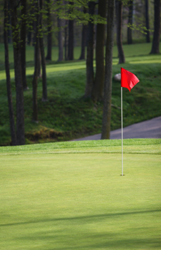Callaway RAZR Fit Woods Review – Adjustable Callaway Woods at Last
Like the Callaway RAZR Fit driver, Callaway RAZR Fit woods feature the
company’s “OptiFit®” system to allow golfers to adjust their clubs to
suit their individual swings. And like the Callaway RAZR Fit driver
(which is the company’s first user-adjustable driver), these woods are
the company’s first user-adjustable fairway woods.
Callaway RAZR Fit woods aren’t quite as customizable as the matching driver, however. Unlike the RAZR Fit driver, RAZR Fit woods do not have adjustable weights. Callaway says the presence of movable, adjustable weights in fairway woods doesn’t significantly alter ball flight, so there’s no need to include them. TaylorMade (the acknowledged “leader of the pack” in movable weight technology) seems to disagree and includes the movable weight technology in its 3-, 5- and 7-woods in addition to its drivers. I’m not sure which company to believe on this issue – they’re both top-rated club makers and I guess they just don’t agree.

At least for now, buyers looking for any type of adjustability in Callaway 7-woods or 9-woods are out of luck, because only 3-wood and 5-wood versions of the Callaway RAZR Fit woods are being offered. TaylorMade apparently disagrees with this approach, too: it includes an adjustable hosel on not just its TaylorMade R11S 3-woods and 5-woods, but also the 7-woods. I’m not sure why Callaway limits the OptiFit® adjustable hosel to the RAZR Fit 3-wood and 5-wood, but that’s the way things are.
Callaway Golf is proclaiming the Callaway RAZR Fit woods as “the ideal combination of distance and accuracy,” and “the most advanced Callaway fairway woods ever made.” Those are pretty lofty claims for a company like Callaway to make. After all, this is one of the world’s premier club makers, and Callaway fairway woods have been beloved by many for a long period of time.
Although these fairway woods have been inspired by Tour players and feature a traditionally-shaped head, they’re likely to appeal to a wide range of golfers. Who wouldn’t want to be able to adjust the club’s face angle to improve the ball flight and accuracy of their shots, whether they’re hitting from the tee or the fairway? Most of us tend to hook or slice the ball from time to time, and Callaway RAZR Fit woods are designed to allow us to compensate for that tendency.
Let’s delve into the characteristics of Callaway RAZR Fit woods a little deeper.
First, these are attractive-looking clubs that have a pleasing appearance at address. The head is fairly compact and the face is fairly shallow, with a low leading edge. To me, the head of a RAZR Fit fairway wood resembles the head of a Diablo Octane Tour wood (that’s a good thing). The crown and face frame the ball nicely and do a good job of inspiring confidence. Player confidence is important – we all know that at least 75% of playing well is “in our heads.” But when it comes down to it, what sets Callaway RAZR Fit woods apart from the company’s other fairway woods is the OptiFit® system.
As I mentioned earlier, the OptiFit® system in the Callaway RAZR Fit driver includes two adjustable weight cartridges (to shift the club’s center of gravity) and an adjustable hosel (to alter the club’s face angle). However, only the adjustable hosel is used in the RAZR Fit fairway woods – there are no movable weights. The OptiFit® hosel system is designed to be easy to use and produce noticeable differences in ball flight. Three face angle settings are possible: Square (“S”), Open (“O”) and Closed (“C”). Basically, adjustments are made by rotating a “cog” on the hosel sleeve. The shaft does not turn as the cog is turned, so grip reminders and shaft graphics remain constant no matter which setting is used.
That’s all there is to this club’s straightforward adjustability – just choose one of the three hosel settings and you’re done. They’re less customizable than TaylorMade R11S woods, but Callaway RAZR Fit woods are a lot easier to configure.
The steel face has been heat-treated to create additional strength. The special heat treatment allows Callaway to aggressively use its proven “Variable Face Thickness” technology (“VFT”) to precisely vary face thickness and enlarge the club’s sweet spot. The result is a hotter face and a more consistent ball flight no matter where impact occurs.
The Bottom Line: For now, at least, Callaway RAZR Fit woods are only available as a 15-degree 3-wood and an 18-degree 5-wood. I love carrying a 7-wood, so personally I wish there was a RAZR Fit wood in that loft. But that won’t stop me from seriously considering putting the two woods that are available into my bag. At $249 each they’re not cheap, but the price is reasonable for a top-quality adjustable fairway wood. Here’s hoping Callaway reads this review and develops a RAZR Fit 7-wood to go along with the others.
From Callaway RAZR Fit Woods to other golf club reviews.



New! Comments
Have your say about what you just read! Leave us a comment in the box below.